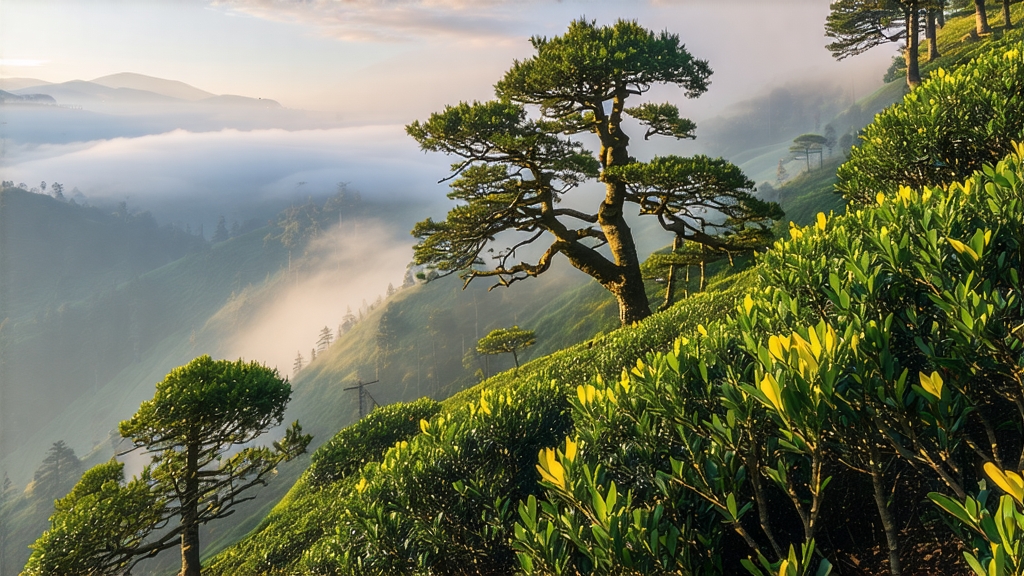
Tucked high on the mist-laced shoulders of Mengding Mountain in Sichuan Province, Mengding Huangya—literally “Yellow Bud from Mengding”—is the tea that Chinese emperors once rationed for themselves and poets praised as “liquid sunrise.” Yet outside China it remains almost unknown, hidden in the long shadow cast by green tea and pu-erh. This article invites international tea lovers to discover a beverage whose gentle golden color, orchid-like fragrance, and honeyed finish capture the quiet elegance of Chinese yellow tea at its most refined.
-
A leaf born of legend
Mengding Mountain, 1,450 m above the Chengdu plain, has been cultivated since the Western Han dynasty (53 BCE). Folklore credits the Taoist monk Wu Lizhen with planting the first seven tea bushes on the summit; by the Tang dynasty (618-907 CE) their offspring were taxed as “immortal tea.” When Song emperor Huizong visited in 1115 CE he found the buds so perfectly yellow—symbol of imperial power—that he decreed Mengding Huangya a tribute tea. For eight centuries the entire crop was carried by fast horses to the Forbidden City, leaving only broken leaves for local farmers. The 1911 revolution ended the imperial order, and with it the tea’s fame. Bushes were uprooted, techniques fragmented, and Mengding Huangya slipped into near extinction until a 1959 government restoration project rediscovered three ancient mother trees still clinging to a cliff. -
What makes a bud “yellow”?
Western drinkers often assume yellow tea is simply green tea with food coloring. In reality it occupies a narrow niche between green and oolong: the leaves are fried like green tea, but then wrapped while still warm and allowed to “seal-yellow” (men huang) for several hours. During this micro-fermentation stage chlorophyll gently breaks down, polyphenols oxidize 5-10 %, and a veil of tiny golden hairs (duo hao) rises to the surface, giving the liquor its luminous straw hue and rounding the grassy edges typical of green tea. The process is laborious—one lapse in timing and the batch collapses into green or drifts toward black—explaining why annual production rarely exceeds 1,200 kg. -
Micro-terroir on a sacred summit
Mengding’s climate is a tea plant’s dream: annual rainfall 2,000 mm, relative humidity 85 %, and 200 fog-bound days that filter sunlight into soft, diffused rays. The soil is acid yellow loam rich in selenium and zinc, drained by countless mountain springs. Insects are few at this altitude, so pesticides are unnecessary; instead farmers plant aromatic citronella grass between rows to repel the occasional leafhopper. The indigenous cultivar is a small-leaf Camellia sinensis var. sinensis locally called “old-mountain fish-tail” because the leaf tip resembles a carp’s tail. Its slow spring flush—only ten picking days between Qingming and Grain Rain—yields buds no longer than 2.5 cm, so tender they can be kneaded into a ball without tearing. -
Handcraft in five acts
a. Plucking: dawn teams of two pickers per bush select only the standard “one bud with one unopened leaf,” dropping the harvest into bamboo tubes lined with banana leaf to prevent bruising.
b. Withering: the tubes are carried to the mountain-top temple courtyard where the leaves are spread on hemp cloth for 90 minutes, losing 8 % moisture while absorbing the scent of nearby magnolias.
c. Pan-firing: a wok heated to 160 °C receives 250 g batches tossed by hand for 3 minutes in a figure-eight motion. The master listens for the crackle that signals enzyme deactivation; when the leaf edge feels like crepe paper he flicks it into a rattan tray.
d. Sealed yellowing: the hot leaves are immediately wrapped in thick yellow cotton cloth, forming football-sized bundles that are stacked inside a bamboo steamer. Every 30 minutes the cloth is opened to release trapped heat and CO₂, then re-wrapped with a gentle knead to redistribute moisture. This cycle continues for 6–8 hours through the night, monitored only by the master’s nose—when the aroma shifts from fresh corn to honeyed orchid the tea is ready.
e. Low-temperature drying: finally the leaves are baked for